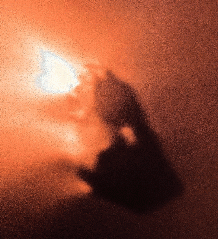
Nucleus of Comet Halley from Giotto
| The Mantle |
|---|

Evidence for Nuclear Mantles
First, comets sublimate less strongly than would be expected on the basis of their nuclear diameter. Comet Halley, for example, would have produced water at 10 times the observed rate if its full surface had been active.Second, spectral line profiles and high resolution images show strong, time variable anisotropies that are best explained by emission of gas from limited vents on a rotating nucleus.
Third, images of the nucleus of comet Halley show a mostly black, inactive surface punctured by regions of strong gas flow.
Rubble Mantle
Large particles ejected by gas drag may be unable to escape the gravitational pull of the nucleus and will fall back to the surface after a sub-orbital hop. Eventually, enough fall-back debris may accumulate to choke the flow of gas from most or all of the nucleus, making a rubble mantle. In this way, a comet might be converted into an apparent asteroid, at least temporarily.Irradiation Mantle
Cosmic rays of Mev energy bombard the nucleus while it is stored in either Kuiper Belt or Oort Cloud. Laboratory experiments suggest that high energy particles will damage molecular bonds in the upper few meters of the nucleus, creating a carbon-rich, hydrogen-depleted irradiation mantle. This mantle differs from the rubble mantle in that it would be present on even a completely inactive nucleus. Indeed, activity due to solar heating might lead to the burial of the irradiation mantle by a rubble mantle.
Last updated Aug 2009
 |
 |
|
| Nucleus | Comet | Jewitt |
|---|